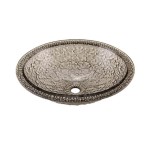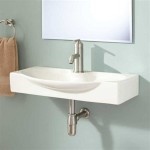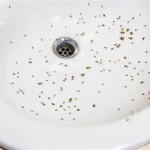How To Fix Bathroom Faucet Pressure Too Low
Low water pressure in a bathroom faucet is a common plumbing issue that can be frustrating. It can impact the effectiveness of handwashing, teeth brushing, and overall hygiene. Identifying the root cause of the problem is crucial for effective troubleshooting and resolution. This article provides a comprehensive guide to diagnosing and fixing low water pressure in a bathroom faucet, covering various potential issues and step-by-step solutions.
Before embarking on any repairs, it is essential to understand the basics of a plumbing system. Water enters a building from a main water line under pressure. This pressure is regulated through the building's pipes to individual fixtures like faucets. A reduction in this pressure at a specific faucet indicates a potential problem, which could be localized to the faucet itself or stem from a broader issue affecting the entire plumbing system. Safety is paramount; always turn off the water supply to the affected faucet before attempting any repairs to prevent flooding and water damage.
Checking the Aerator
The aerator is a small screen-like device located at the tip of the faucet spout. Its function is to mix air into the water stream, creating a more consistent and splash-free flow. Over time, the aerator can become clogged with mineral deposits, sediment, and debris, restricting water flow and causing low pressure. This is often the most common and easily fixable cause of low water pressure.
To check and clean the aerator, first, locate it at the end of the faucet spout. In most cases, it can be unscrewed by hand. If it is tight, use an adjustable wrench, being careful to protect the faucet finish with a cloth or towel. Once removed, examine the aerator for any visible signs of blockage. Rinse it thoroughly under running water to dislodge any loose debris. For stubborn mineral deposits, soak the aerator in a solution of white vinegar and water for several hours or overnight. The vinegar will help dissolve the mineral buildup. After soaking, scrub the aerator with a small brush (an old toothbrush works well) to remove any remaining debris.
After cleaning, reassemble the aerator and test the water pressure. If the pressure has improved, the aerator was likely the culprit. If the pressure remains low, proceed to investigate other potential causes.
Inspecting the Supply Lines
The supply lines are the flexible hoses or rigid pipes that connect the faucet to the water supply valves under the sink. These lines can become kinked, twisted, or clogged, restricting water flow and causing low pressure at the faucet. Inspecting these lines is a crucial step in diagnosing the problem.
First, locate the shut-off valves under the sink, typically one for hot water and one for cold water. Ensure these valves are fully open. If they are partially closed, this could be the source of the low pressure. If the valves appear to be fully open, examine the supply lines for any visible kinks or twists. Straighten out any kinks or twists in the lines. If the lines are rigid copper pipes, ensure they are not dented or damaged in any way.
To check for clogs inside the supply lines, first, shut off the supply valves. Disconnect the supply lines from both the faucet and the shut-off valves. Have a bucket ready to catch any residual water. Inspect the inside of the lines for any sediment or debris. Flush the lines with water, directing the water stream into the bucket. If the lines are severely clogged, they may need to be replaced. Replacement supply lines are readily available at most hardware stores. When replacing supply lines, ensure they are the correct length and type for the faucet and plumbing system.
After inspecting and cleaning or replacing the supply lines, reconnect them to the faucet and the shut-off valves. Ensure all connections are tight to prevent leaks. Turn the shut-off valves back on and test the water pressure. If the pressure has improved, the supply lines were likely the source of the problem. If the pressure remains low, consider other potential causes.
Checking the Faucet Cartridge or Valve
The faucet cartridge (in single-handle faucets) or valve (in two-handle faucets) controls the flow of water. Over time, these components can become worn, damaged, or clogged with mineral deposits, leading to reduced water flow and low pressure. Replacing or cleaning the cartridge or valve can often resolve the issue.
To access the cartridge or valve, first, shut off the water supply to the faucet. For a single-handle faucet, typically, you will need to remove the handle. The handle is usually held in place by a screw, which may be hidden under a decorative cap. Use a screwdriver to remove the screw and lift off the handle. Once the handle is removed, you will see the cartridge. The cartridge is usually held in place by a retaining clip or nut. Remove the clip or nut and carefully pull out the cartridge. For a two-handle faucet, the valves are located under the handles. Follow a similar procedure to remove the handles and access the valves.
Inspect the cartridge or valve for any signs of wear, damage, or mineral buildup. If the cartridge or valve is damaged, it should be replaced. Replacement cartridges and valves are available at most hardware stores. When purchasing a replacement, ensure it is the correct type and size for the faucet model. If the cartridge or valve is not damaged but appears to be clogged with mineral deposits, try soaking it in a solution of white vinegar and water for several hours or overnight. After soaking, scrub it with a small brush to remove any remaining debris.
Before installing the new or cleaned cartridge or valve, inspect the faucet body for any debris or mineral buildup. Clean the faucet body thoroughly. Install the new or cleaned cartridge or valve, ensuring it is properly aligned and secured. Reassemble the faucet handle and turn the water supply back on. Test the water pressure. If the pressure has improved, the cartridge or valve was likely the source of the problem. If the pressure remains low, consider other potential causes.
Addressing Issues with the Shut-Off Valves
The shut-off valves located under the sink control the water supply to the faucet. Although seemingly simple, these valves can sometimes be the source of low water pressure. The valve mechanism itself can become corroded or partially blocked with sediment over time, restricting water flow even when the valve appears to be fully open.
The first step is to visually inspect the shut-off valves for any signs of corrosion or damage. If the valve is visibly corroded or leaking, it is best to replace it entirely. A corroded valve may be difficult to operate and could potentially fail, leading to a water leak. Attempting to force a corroded valve can cause further damage.
To check if the shut-off valve is restricting water flow, completely close the valve and then very slowly open it. Listen carefully for any unusual noises, such as a hissing or sputtering sound. This could indicate that the valve is not fully opening or that there is an obstruction within the valve. Another method is to remove the supply line connected to the valve and briefly open the valve into a bucket. Observe the water flow. If the flow is weak or restricted compared to other faucets in the house, the valve is likely the problem.
Replacing a shut-off valve requires shutting off the main water supply to the house. This is usually located near the water meter. Once the main water supply is shut off, disconnect the water supply line from the old valve. Use two wrenches – one to hold the pipe leading to the valve and the other to loosen the connection on the valve itself. This prevents twisting or damaging the pipe. Remove the old valve and clean the threads on the pipe. Apply Teflon tape to the threads of the new valve to create a watertight seal. Screw the new valve onto the pipe, tightening it securely with the two wrenches. Reconnect the water supply line to the new valve. Slowly turn the main water supply back on and check for any leaks around the valve and the connections. If the pressure has improved after replacing the valve, it was likely the source of the problem.
Investigating Building-Wide Plumbing Issues
If the above steps do not resolve the low water pressure in the bathroom faucet, the problem may stem from a broader issue affecting the entire plumbing system of the building. This is more likely to be the case if other faucets or fixtures in the house are also experiencing low pressure.
One potential cause is a problem with the main water supply line entering the building. This could be due to a partially closed main shut-off valve. Locate the main shut-off valve, usually near the water meter, and ensure it is fully open. Another possibility is a leak in the main water supply line. This can be difficult to detect as the leak may be underground. Signs of a leak include unusually high water bills, damp areas in the yard, or a decrease in water pressure throughout the house.
Another possible cause of low water pressure throughout the building is a problem with the pressure regulator. The pressure regulator is a device that reduces the water pressure from the main water supply to a safe and consistent level for use in the building. A faulty pressure regulator can cause low water pressure throughout the entire system. The pressure regulator is typically located near the main water meter. You may need to consult with a qualified plumber to diagnose and repair or replace a faulty pressure regulator.
Older homes with galvanized steel pipes can experience low water pressure due to corrosion and mineral buildup inside the pipes. Over time, the pipes can become severely restricted, reducing water flow. This is a more complex problem to address as it may require replacing the entire plumbing system or using specialized cleaning techniques. Consulting with a qualified plumber is essential in this situation. A plumber can inspect the pipes and recommend the best course of action.
In multi-unit buildings, low water pressure may be caused by issues with the building's central plumbing system. This could include problems with the water pumps, storage tanks, or pressure regulators. In such cases, it is best to contact the building management or a qualified plumbing professional to investigate and resolve the problem.

How To Fix Low Water Pressure Taps And Shower Head

How To Fix Low Water Pressure In Faucet

How To Fix Low Or No Water Pressure For The Kitchen Bathroom Faucet In Time

How To Fix Faucet Slow Water Flow Easy Steps Solve From Taps

7 Reasons Why Your Kitchen Sink Water Pressure Is Low Lee S Air

How To Fix Low Or No Water Pressure For The Kitchen Bathroom Faucet In Time

Don T Know How To Fix Low Water Pressure On The Top Floor Get These Tips Ideas By Mr Right

How To Fix Low Water Pressure In A Faucet

How To Fix Low Water Pressure Taps And Shower Head

What Slow Flow From Your Faucet Means Flader Plumbing
Related Posts







